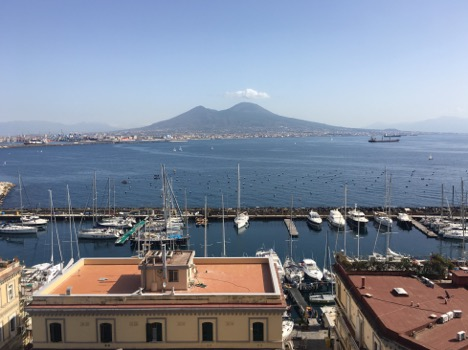The Perfect Weekend in Napoli
What makes ‘Napoli’ so special? Perhaps it is the sought after ‘pizza Napoletana’ with its handmade dough that rises into a thick, perfectly structured crust. The pizza’s sweet tomatoes are grown in the rich volcanic soil near Mount Vesuvius. An active volcano, Vesuvius destroyed the once nearby city of Pompeii in 79 AD. Maybe it is Napoli’s idyllic location. Near the volcano, Napoli lies on the beautiful coast of southern Italy and is only about 200 kilometers from Rome. Italians and foreigners alike flock to this port city for the summer weather and lovely seaside life including the tasty seafood.
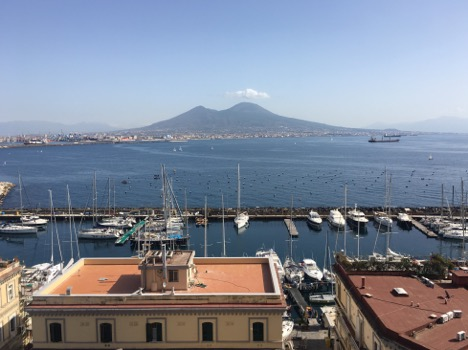
The ‘Napoletani’ are amazingly warm and welcoming. They also have an air of mystery about them. Locals abide by many superstitions that are centuries old. Napoli’s immense charm comes from this combination of attributes; the abundance of kindness, sea, sun, and heavenly food served with a slice of folklore and intrigue. The secrets to relaxation and potential for upmost wonder awaits everyone in Napoli.
The Pizza
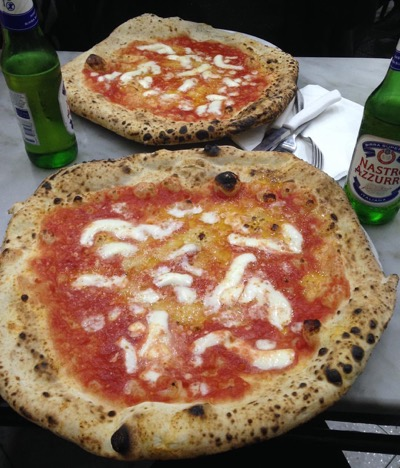
Pizza as we know it today, wood-fired and topped with fresh tomatoes and other ingredients, was born in Napoli. Compared to Rome’s thin pizza, Napoli’s pizza has a thicker, more doughy crust and is much cheaper. One pizza costs about four euros.
The pizza is simple, but kept that way for a reason; it’s made with outstandingly highquality products so you can taste every single one. There are only two styles; ‘pizza margarita’ (tomatoes, mozzarella, basil, and extra virgin olive oil) or ‘pizza marinara’ (tomatoes, garlic, oregano, and extra virgin olive oil). The margarita calls for ‘Mozzarella di Buffalo Campana,’ a type of mozzarella traditionally made from milk of water buffalo that roam Campania, the region containing Naples. This mozzarella has the esteemed ‘Denominazione di Origine Protetta’ (DOP) or Protected Designation of Origin (PDO) label.
The Pastries and Coffee

As for sweets, Napoli boasts amazing gelato, as well as some unique pastries including ‘babà’ and ‘sfogliatelle’. The ‘babà’ is a little sticky cake filled with fresh cream soaked in rum. There are two types of ‘sfogliatelle,’ the traditional ‘sfogliatella riccia,’ a flakey shell-shaped pastry with thin, crispy layers, or the “sfogliatella frolla,” a soft, round pastry with a more bread- like dough that delicately melts in your mouth. Both are filled with a thick cream made with ricotta, cinnamon, and sugar.
Often paired with a cappuccino, this means you are in for a double treat. Napoli is renowned for its coffee. Ask anyone in Italy to confirm this; Neapolitans claim that their high quality volcanic water influences their flavorful cooking. This water creates an exquisite, unparalleled espresso and also adds to the perfectness of their pizza dough and taste of their pasta. So why is the coffee so amazing in Naples? The water.
The Fried Food
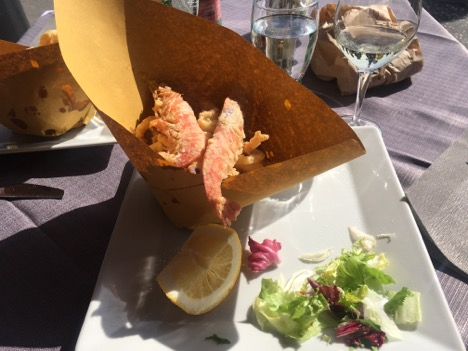
Since Napoli is by the sea there are lots of fresh and fried fish. ‘Gamberi fritti’ or fried prawns and ‘calamari’ are a must-have. There are many other fried snacks including fried balls of mozzarella, ‘mozzarella in carrozza,’ mozzarella and vegetable filled turnovers, ‘panzerotti,’ fried mashed potato stuffed with cheese and sometimes salami or ham, ‘crocchè di patate,’ and ‘zeppole,’ delightful sugary bite-sized doughnuts.
The People
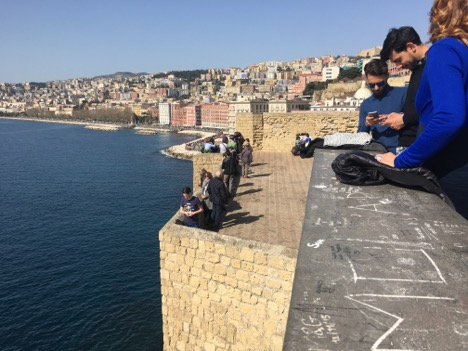
The people of Napoli are some of the friendliest in Italy. They will talk to you, even if you do not understand each other’s languages, and you will become friends! They will recommend places for you to drink, eat, and visit. Look for bars and restaurants filled with locals so you can make friends and get these recommendations.
Napoli has a bad reputation of being a dangerous city. You should be attentive, especially around the main train station, however this is true wherever you are traveling. Hold onto your bags and do not keep valuables in easily picked pockets. Then embrace the chaos of the city; it comes with the tranquility of the sea, sunshine, and welcoming people.
The Superstitions
‘Le superstizioni’ are ripe throughout Italy and in Napoli they have become a way of life. Fiercely tied to religion, superstitions have provided a sense of stability and reassurance for Neapolitans for centuries. There is a saying in Napoli, ‘L’uocchie so d’e peggio di scuppettate’ meaning the eyes are more dangerous than gunshots. It is believe that the ‘jettatore,’ a person with the ‘malocchio’ or evil eye can simply look at another and cause them misfortune.
For protection Neapolitans wear amulets, either a little horn, ‘il cornicello’ or a hunchback, ‘il gobbo.’ Years ago, hunchbacks were often hired to work for others because they were said to bring good fortune and business. They even visited newly engaged couples to bring them happiness and prosperity in marriage. It is telling that Neapolitans not only believe in bad omens, but in combatting them with good ones. A mix of this light and dark, makes Napoli feel even more magical and the people even more kind-spirited.
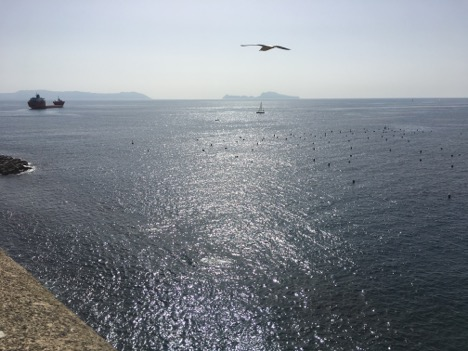
Napoli in One Weekend
Maybe you are visiting Rome from abroad. You have seen the Colosseum, walked through the impressive halls of the Vatican Museums, and eaten all the carbonara and thincrusted ‘pizza Romana’ that you can handle. Now all you crave is a few days outside the city, a chance to see how other Italians live, and to spend some time basking in the sun and sea breeze. Pack a weekend bag, Napoli is calling!
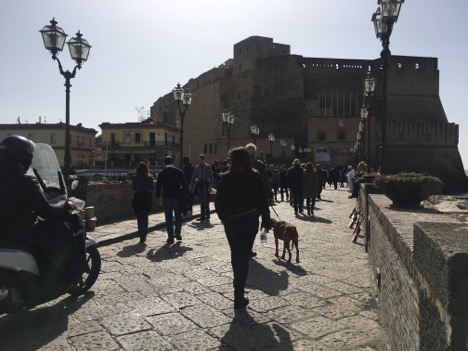
Book a place to stay, either a hotel or apartment near the sea and away from the train station as it is less safe. The contemporary Hotel Piazza Bellini next to the lively piazza and not far from the sea is a good choice. There are also many elegant hotels along the seafront on Via Partenope, including Grand Hotel Vesuvio, Grand Hotel Santa Lucia, and Excelsior.
Buy train tickets online at either Trenitalia or Italo at least two or three weeks beforehand to spend less on the fares. On a Friday afternoon take the train from Roma Termini or Roma Tiburtino to Napoli Centrale. The journey is only about one hour and fifteen minutes and you can easily grab a taxi at the central station. Upon arrival, drop off your bags and freshen up for dinner. It is time to try some delicious food.
We are saving ‘pizza Napoletana’ for tomorrow, so tonight choose between Neapolitan cuisine with a twist at or deliciously grilled and fried fish and vegetables at one of the restaurants near the sea. Near Piazza Bellini there is the innovative ‘La Stanza del Gusto’ which only uses locally sourced products to make their modern Neapolitan dishes. By the sea there is ‘Il Ristorantino dell’Avvocato’ where you can either enjoy freshly caught fish in pastas and other dishes or try the meat with seasonal vegetables.
On Saturday, wake up and open your window. Breathe in the sea air and feel the sun’s rays. Wear comfortable shoes and light layers today, because we are going to walk along the ‘lungomare,’ the 2.5 kilometer seafront promenade that goes along Via Partenope and Via Francesco Carrociolo. Find the nearest ‘bar’ and order a cappuccino and ‘sfogliatelle’ of your choosing. At this time of day most likely it will still be warm, fresh from the oven.
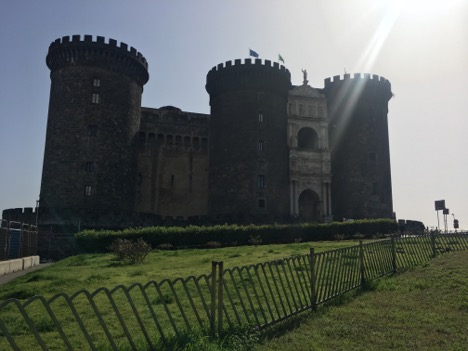
From Piazza Bellini go to ‘Castel Nuovo’ and then walk toward ‘Castel dell’Ovo.’ From the grand hotels, you will be going the opposite direction, so head to ‘Castel dell’Ovo’ first and then ‘Castel Nuovo.’ Not only will we be viewing the glistening sea, this is your first chance to take in the Neapolitan locals. For many it is a weekend ritual, a time to dress up and spend time with loved ones. Look out for Mount Vesuvius looming over the water across the bay.
‘Castel Nuovo’ or New Castle is an impressively imposing-looking medieval castle built in 1279. Walk into the expansive courtyard for free, you can easily imagine it was once bustling with courtiers and grand nobility, or pay to see more inside the castle.
‘Castel dell’Ovo’ is the oldest castle in Naples. Legend says that an egg was hidden somewhere in the fortress while it was being built and this egg keeps the structure intact. This castle is enchanting and romantic with wide, winding stairs that lead up to beautiful views of the sea, the far off horizon, and the city behind. Make sure you go all the way up to the top for the final view. Often the castle holds contemporary art exhibitions in the rooms below.
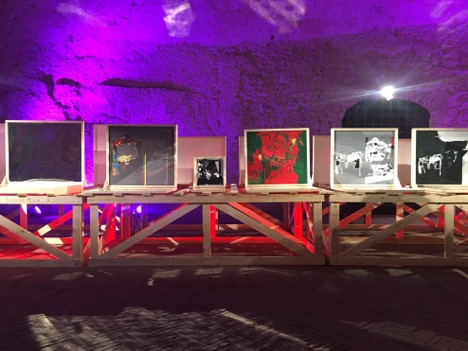
If you are hungry, one option is to eat lunch here along the ‘lungomare’ or at least grab a snack; some calamari and white wine. Find exquisite seafood and sea views at ‘Il Transatlantico’ next to ‘Castel dell’Ovo’ or perfectly priced fish at ‘Trattoria Castel dell’Ovo.
In the afternoon ride the funicular, Napoli’s cable railways dating back to 1928, up to the hill district of ‘Vomero’ for some spectacular views of the city at golden hour. Vomero is known for shopping and certain areas, like Antignano, for perfectly preserving its historic architecture.
Buy an ANM ticket at a ‘tabaccheria’ or news stand for only a few euros. Head toward ‘Parco Margherita’ by taxi or on foot. Hop on the funicular for the five minute ride, get off at ‘Cimarosa,’ and take in the breathtaking panorama of Napoli below.
If you did not eat a proper lunch, ‘Friggitoria Vomero’ is only a few short steps away. Sample sweet or savory fried snacks including the stuffed turnovers, ‘panzerotti’ and little doughnuts, ’zeppole,’ buy dave room for pizza tonight! Linger, explore as you wish, and watch the setting sun emphasize the warm hues of Napoli.
Take the funicular back down, pause for a moment at your hotel, and then head to ‘Pizzeria da Michele’ for dinner. This famous pizzeria always has a queue, especially at the weekends. Take a number and wait outside. The wait will be perfect; not only will you become ravenous and ready for the freshest, most tantalizing pizza you have ever had, you will make friends. The locals are always ready for a chat and everyone here will be in good spirits.
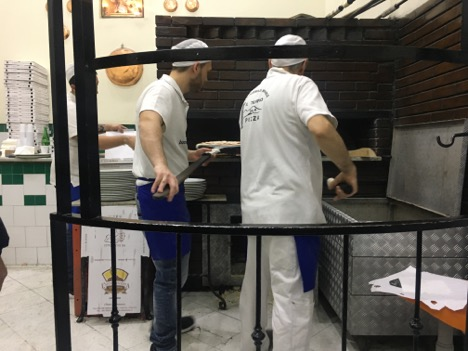
Wake up on Sunday to another morning of impeccable Neapolitan coffee and treats. Find a spot near your hotel or apartment or try the expansive and elegant ‘Gran Caffè Gambrinus’ near Piazzi Trieste. Fuel up because we are heading to Mount Vesuvius today. Wear hiking shoes and bring a water bottle and some snacks, maybe some ‘panini’ and pastries from the morning’s café.
Take the train from Napoli Centrale to Ercolano, the nearest stop to the volcano, and then a taxi or the shuttle bus to the trail. The shuttle Vesuvius Express Ercolano runs every forty minutes. The hike takes you 200 meters from the top and then you loop around the crater. Pay for an entrance ticket once you reach the crater. There are free ten minute tours available in English. You can also book a private tour in advance if desired. Give yourself a few hours in all and become mesmerized by the power and vitality of the volcano’s presence. Admire the glorious views of Naples and the bay.
After you have finished your descent and have returned to Ercolano, you have two choices. Go back to Napoli for a relaxing evening near the sea at one of the restaurants that you missed yesterday or fill your afternoon with a custom tour of Pompeii were you will explore the archeological sites of this ruined city and learn about life before the fatal eruption of Vesuvius.
If you choose Napoli, return on the train and if you choose Pompeii, enjoy imagining the rich lives of these ancient people and what could have been. Take the forty minute train ride back to Napoli early enough to see one final the sunset and enjoy your last Neapolitan meal. Pack your bags ready to depart in the morning. Dream sweetly of the city with friendly people, an intriguing history, and the perfect pizza.
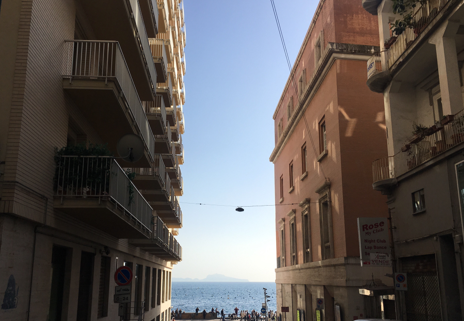
Written by: Heeley Becky
If you liked this article, read also: Top five things to do on the Amalfi Coast
